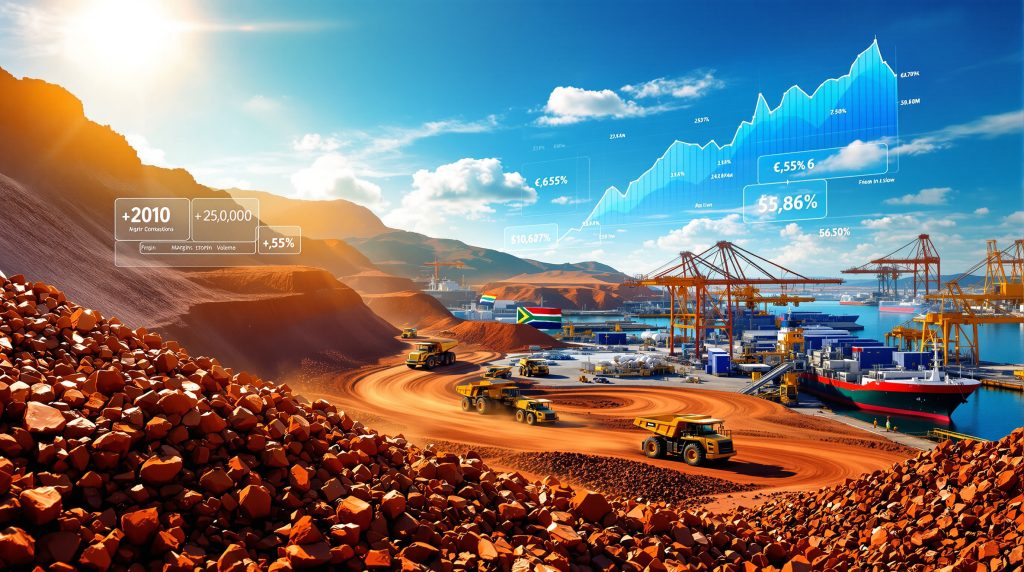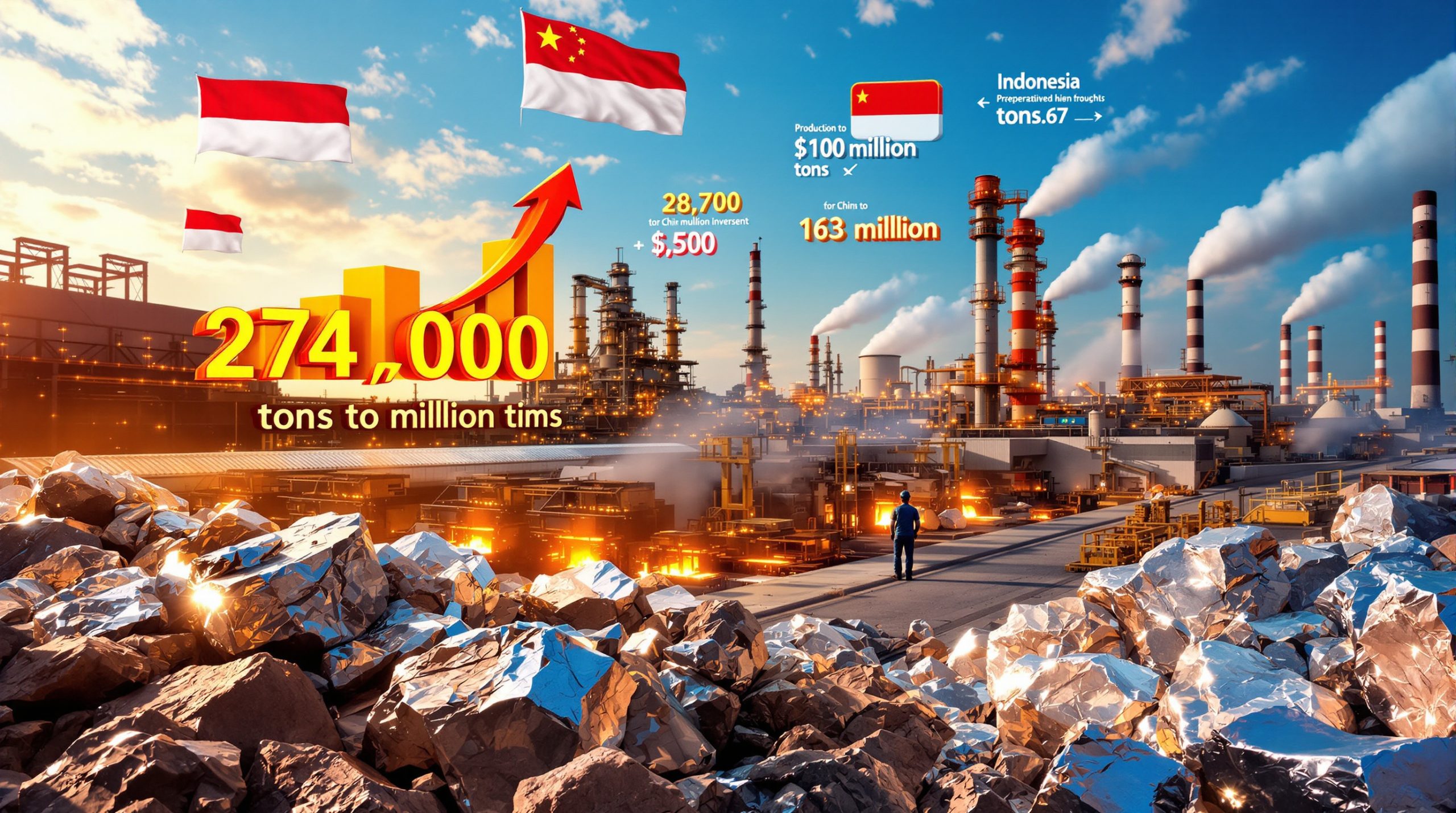What Factors Are Driving Margin Compression for South African Iron Ore Producers?
South African iron ore exporters confront an increasingly complex operational environment that threatens their traditional profitability structures. The convergence of evolving global trade dynamics, infrastructure limitations, and shifting steelmaking preferences has created unprecedented pressure on margins across the sector. Furthermore, current iron ore price trends indicate additional challenges for producers managing the Kumba iron ore margin squeeze.
Rising Transportation Costs and Changing Trade Routes
The fundamental economics of South African iron ore exports have shifted dramatically as China's dominance in the market has expanded. Chinese purchases now represent approximately 65% of South African iron ore exports, a significant increase from the previous 50% market share according to recent industry analysis. This geographic concentration creates substantial cost pressures through increased freight expenses over longer shipping distances.
European markets, while offering better proximity advantages, have experienced reduced demand patterns that limit their viability as alternative destinations. The extended shipping routes to Asian markets directly impact netback pricing calculations, where transportation costs represent an increasingly significant portion of the total cost structure.
The freight cost burden becomes particularly acute when considering that South African producers must compete with Australian and Brazilian suppliers who benefit from shorter shipping distances to key Asian steel production centres. This geographic disadvantage translates directly into margin compression as producers absorb higher transportation costs to maintain market competitiveness.
Infrastructure Bottlenecks Hampering Export Efficiency
Transnet's operational challenges continue to create significant disruptions across the iron ore export supply chain. The state-owned logistics provider's rail and port performance issues have resulted in production stockpiling, creating additional carrying costs for producers while simultaneously limiting export volumes during peak demand periods.
These capacity constraints force producers to explore alternative logistics solutions, often at premium pricing that further erodes margins. However, improved haulage operations in other regions demonstrate potential pathways for operational efficiency gains that could benefit the sector.
Production disruptions stemming from transportation unreliability require additional working capital allocation for inventory management, representing an opportunity cost that directly impacts return on invested capital across the sector.
Why Are Traditional Iron Ore Quality Premiums Under Threat?
The premium pricing model that has sustained South African iron ore producers faces fundamental challenges from evolving steelmaking technologies and changing raw material preferences. These shifts threaten the historical advantages that high-grade South African ore has enjoyed in global markets.
Steelmaker Preference Changes
Rising coking coal costs have fundamentally altered raw material selection criteria for steel producers worldwide. As coking coal prices increase, steelmakers demonstrate stronger preferences for pelletised iron ore over traditional lump and fines products, as pellets require less coking coal in the steelmaking process.
This preference shift creates particular challenges for South African producers, as approximately two-thirds of Kumba's 35 to 37 million tons annual production consists of lump iron ore, which traditionally commanded premium pricing due to superior handling characteristics and reduced processing requirements.
Energy efficiency considerations in steel production have become increasingly important as environmental regulations tighten globally. Steelmakers prioritise raw materials that enable lower overall energy consumption, favouring processing methods that reduce coking coal dependence. Consequently, demand insights for iron ore suggest continued evolution in customer requirements.
Chemical Composition Valuation Adjustments
The valuation framework for iron ore chemical composition has undergone significant changes that impact South African ore competitiveness:
| Component | Traditional Valuation | Current Market Trend | Impact on SA Producers |
|---|---|---|---|
| Iron Content (64%+) | Premium pricing | Continues strong demand | Positive competitive advantage |
| Silica Presence | Neutral to slight negative | Decreased valuation | Negative impact on margins |
| Alumina Content | Lower priority factor | Increased premium value | Mixed impact depending on ore body |
| Phosphorus Levels | Quality constraint | Stricter limitations | Potential quality challenges |
The adjustment toward higher alumina valuations particularly benefits pelletised and fine iron ore products, which typically contain higher alumina concentrations compared to lump ore. This shift challenges the traditional premium structure that has supported South African lump ore pricing.
How Significant is the Financial Impact on Major Producers?
The Kumba iron ore margin squeeze translates into measurable financial consequences across South Africa's iron ore sector, with varying degrees of exposure based on production scale, business models, and operational efficiency.
Earnings Sensitivity Analysis
Financial modelling reveals significant earnings volatility tied to netback price fluctuations. Every $10 per ton change in netback pricing affects Kumba's EBITDA by approximately 20%, demonstrating the sector's high sensitivity to margin compression. This sensitivity extends throughout the value chain with varying degrees of impact:
- Kumba Iron Ore: 20% EBITDA sensitivity to $10/tonne netback changes
- African Rainbow Minerals: 10% EBITDA impact from similar price movements
- Exxaro Resources: 2% earnings impact through Sishen Iron Ore Company stake
The cumulative effect across the sector represents hundreds of millions in potential earnings volatility based on margin fluctuations, emphasising the critical importance of operational efficiency and cost management initiatives. In addition, comparing performance with the largest iron ore mines globally highlights the competitive challenges facing South African producers.
Current Market Pricing Dynamics
Iron ore futures currently trade around $103 per tonne in Singapore, with benchmark pricing exhibiting volatility that creates planning challenges for producers. According to Fastmarkets data, recent trading volumes for iron ore contracts have reached record levels, indicating heightened market activity.
Kumba reported an average realised price of $91 per ton for the six months ended June, representing a premium above the benchmark of $84 per ton over the same period. However, this premium faces ongoing pressure from the factors outlined above, creating uncertainty around future pricing realisation.
Regional pricing differentials continue to favour producers with geographic proximity to major consumption centres, placing South African exporters at a structural disadvantage that requires operational excellence to overcome.
What Operational Strategies Are Producers Implementing?
South African iron ore producers are pursuing comprehensive operational transformation initiatives to maintain competitiveness despite mounting margin pressure. These strategies focus on enhancing product quality, improving operational efficiency, and reducing cost structures.
Quality Enhancement Initiatives
Investment in advanced processing technologies represents a primary strategic focus for maintaining premium pricing. Ultra-high-dense-media-separation technology enables producers to upgrade ore grades while reducing waste generation, potentially offsetting some margin pressure through improved product positioning.
Facility upgrades concentrate on maximising recovery rates of high-grade ore while extending mine life through enhanced extraction efficiency. These improvements require significant capital investment but offer long-term competitive advantages in an increasingly challenging market environment.
Waste reduction programmes target both operational costs and environmental compliance requirements, creating dual benefits for margin protection and regulatory compliance. Advanced sorting technologies enable more precise ore grade control, improving final product consistency and customer satisfaction.
Cost Management and Operational Efficiency
Workforce optimisation initiatives focus on improving productivity per employee while maintaining operational safety standards. Fleet rationalisation programmes reduce equipment maintenance costs and improve asset utilisation rates across mining operations.
Energy consumption reduction represents a critical focus area as electricity costs continue to rise. Predictive maintenance technologies enable more efficient equipment utilisation while reducing unplanned downtime that impacts production volumes.
Supply chain optimisation strategies target procurement costs, logistics efficiency, and inventory management improvements. These initiatives require coordination across multiple operational areas but offer significant potential for cost reduction.
How Are Global Market Dynamics Affecting South African Exports?
International iron ore market evolution presents both challenges and opportunities for South African producers, requiring strategic adaptation to maintain competitive positioning in an increasingly complex global market.
Chinese Steel Industry Outlook
Fourth-quarter economic data from China will provide critical insights into future iron ore demand patterns, with implications for global pricing structures and volume requirements. Chinese infrastructure spending patterns directly influence high-grade ore consumption, as quality requirements increase with advanced steelmaking processes.
Long-term demand projections suggest continued preference for high-quality ore, potentially supporting premium pricing for South African producers who can maintain competitive cost structures. However, this advantage requires operational excellence to overcome geographic disadvantages.
Alternative market development strategies focus on diversifying customer bases beyond Chinese steel producers, though limited alternative demand sources constrain these efforts. European and other regional markets offer proximity advantages but typically involve smaller volume commitments.
Competitive Landscape Analysis
Global iron ore production remains concentrated among major suppliers with varying competitive advantages:
| Producer Region | Primary Advantages | Key Challenges | Approximate Market Share |
|---|---|---|---|
| Australia | Asian market proximity, scale | Higher labour costs, regulatory complexity | 40%+ |
| Brazil | Large reserve base, established infrastructure | Transportation distances, political risks | 25%+ |
| South Africa | High-grade ore quality, processing expertise | Infrastructure constraints, logistics costs | 5% |
| Other Regions | Niche market positioning | Limited scale, higher costs | 30% |
This competitive landscape emphasises the importance of quality differentiation and operational efficiency for South African producers to maintain market position despite scale disadvantages.
What Technology Investments Are Reshaping the Industry?
Technological advancement represents a critical pathway for South African iron ore producers to maintain competitiveness and protect margins in an increasingly challenging market environment.
Processing Technology Advancements
Dense media separation improvements enable more precise ore grade control while reducing processing waste. These technologies require significant capital investment but offer long-term competitive advantages through improved product quality and reduced operating costs.
Automated sorting and grading systems reduce labour costs while improving product consistency. Real-time quality monitoring capabilities enable immediate process adjustments, minimising off-specification production and improving customer satisfaction.
Predictive maintenance implementation across processing facilities reduces unplanned downtime while optimising maintenance costs. These systems utilise advanced analytics to anticipate equipment failures before they impact production schedules.
Logistics and Transportation Innovation
Rail capacity optimisation projects focus on maximising throughput through existing infrastructure while reducing per-ton transportation costs. These initiatives require coordination with Transnet and other logistics providers but offer significant potential for margin improvement.
Port efficiency enhancement programmes target reduced dwell times and improved loading rates. Alternative transport route development explores options for reducing dependence on constrained infrastructure networks.
Digital supply chain management systems provide improved visibility and control over material flows from mine to customer. These technologies enable better planning and reduced working capital requirements through optimised inventory management.
How Do Environmental and Social Factors Influence Margins?
Environmental and social considerations increasingly impact operational costs and investment requirements across the South African iron ore sector, creating additional pressure on already constrained margins.
Sustainability Compliance Costs
Environmental remediation requirements continue to expand as regulatory frameworks evolve. These obligations require ongoing capital allocation that directly impacts cash flow available for productivity investments or shareholder returns.
Carbon footprint reduction initiatives necessitate investments in cleaner technologies and energy efficiency improvements. While these investments offer long-term operational benefits, they require immediate capital deployment that impacts near-term financial performance.
Water management system upgrades represent critical infrastructure investments required for operational continuity and regulatory compliance. These systems require significant capital investment and ongoing operational costs that affect margin calculations.
Social Licence to Operate
Stakeholder engagement programmes require ongoing investment in community development and relationship management. These costs, while essential for operational continuity, represent overhead that impacts overall profitability.
Local employment and procurement requirements create operational constraints that may increase costs compared to purely market-driven sourcing decisions. However, these investments often provide long-term benefits through improved community relations and operational stability. Furthermore, South African beneficiation opportunities present potential pathways for value addition despite initial capital requirements.
Regulatory compliance expenses continue to increase as oversight requirements expand. Long-term community partnership investments require ongoing financial commitments that must be factored into long-term financial planning.
What Does the Future Hold for South African Iron Ore Margins?
The outlook for South African iron ore margins depends on successful navigation of multiple interconnected challenges while capitalising on quality advantages and operational improvements.
Short-term Outlook (2025-2026)
Iron ore price volatility expectations suggest continued market uncertainty, with Chinese economic data providing critical demand signals. Infrastructure improvement timelines, particularly regarding Transnet performance, will significantly impact operational efficiency and cost structures.
Chinese demand recovery scenarios range from continued weakness to gradual improvement, with implications for both volume and pricing. Premium pricing sustainability depends on successful differentiation through quality and service advantages.
Market consensus suggests iron ore prices may struggle to maintain current levels above $100 per ton, particularly if Chinese economic data disappoints in the fourth quarter. S&P Global analysis indicates that price environment would intensify pressure on producers to reduce costs and improve operational efficiency.
Long-term Strategic Positioning
Technology adoption impact on competitiveness will become increasingly important as producers seek sustainable advantages in a challenging market environment. Market differentiation through quality focus offers potential for premium pricing maintenance, though operational excellence remains essential.
Diversification opportunities require careful evaluation of capital allocation priorities, balancing growth investments against margin protection initiatives. The risk-return profile of various strategic options must consider both market volatility and operational complexity.
Capital allocation priorities for margin protection should focus on technologies and processes that provide sustainable competitive advantages rather than short-term cost reductions that may compromise long-term positioning. Consequently, addressing the Kumba iron ore margin squeeze requires comprehensive strategic planning across multiple operational dimensions.
Disclaimer: This analysis is based on publicly available information and industry reports. Iron ore market conditions and company performance can change rapidly based on global economic conditions, particularly Chinese steel industry demand patterns. Investors should conduct independent research and consider consulting financial advisors before making investment decisions related to iron ore producers or related securities.
Looking to Capitalise on Iron Ore Market Opportunities?
Discovery Alert's proprietary Discovery IQ model delivers real-time notifications on significant ASX mineral discoveries, helping subscribers identify actionable opportunities ahead of broader market movements. Begin your 30-day free trial today to gain the market-leading edge you need in the evolving commodities landscape.




